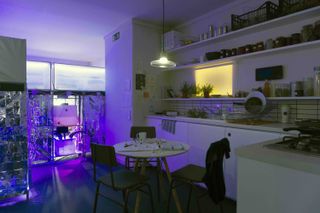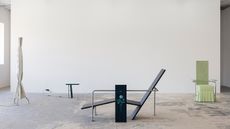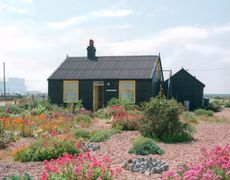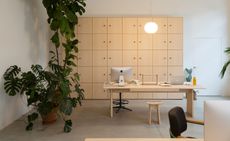Superflux: making climate change ‘tangible, relatable and specific’
Design studio Superflux explores some of the biggest issues humans currently face, and is now tipped by Formafantasma as one of 25 creative leaders of the future, in Wallpaper’s 25th Anniversary Issue ‘5x5’ project

Superflux is a design studio whose work crosses technology, politics, and nature. The London-based practice looks to the future to address the challenges we currently face in modern-day life. They have worked with organisations that include the Red Cross and the UK’s Cabinet Office, and created powerful installations across the globe.
From synthetic biology to ecological interdependence in a post-Anthropocene world, Superflux explores some of the biggest issues humans currently face. The critically acclaimed studio works at the intersection of the climate crisis, politics, and artificial intelligence. It has recently been named as one of 25 creative leaders of the future by Formafantasma, for Wallpaper’s 25th Anniversary Issue ‘5x5’ project.

Mitigation of Shock, an apartment interior that imagined life under future restrictions due to climate change. Courtesy of Superflux
Founded in 2009 by Royal College of Art graduates Anab Jain and Jon Ardern, the London-based practice ‘constructs narratives, worlds, and tools that provoke viewers to engage with the rapidly changing world’, explains Jain. While studying under the tutelage of Anthony Dunne and Fiona Raby at the RCA, the pair were encouraged to consider the implications of emerging technologies on modern society which in turn led them to found Superflux.
Superflux: immersive installations addressing big issues
Currently operating out of Somerset House, Superflux creates installations that make viewers carefully consider the planet. From multispecies dining tables oozing with fungi to forests of dead blackened pine trees, the Anglo-Indian studio takes highly complex subject matters and develops clear and interactive exhibitions. Having exhibited at MoMA New York, the National Museum of China, and the V&A, London, the practice has garnered international recognition, with its most notable project to date being Mitigation of Shock.
Commissioned by Suncorp and the Centre de Cultura Contemporània de Barcelona, Mitigation of Shock was an attempt to make climate change ‘tangible, relatable and specific’, says Jain. Following extensive research and interviews with experts from Nasa and the UK Met Office, Superflux skilfully constructed a future apartment where ‘people could step inside a family home and experience what the restrictions of this future might feel like’, states Jain. This project was a real turning point for the practice.

Invocation for Hope at the Museum of Applied Arts as part of the Vienna Biennale for Change 2021.
However, Invocation for Hope, an installation that turns trees into art (some 400 pine trees), exploring the impact humans have on the planet, and which is currently on show at the Museum of Applied Arts in Vienna (until 3 October 2021), has been Superflux’s biggest installation in terms of scale and ambition so far.
The studio also showed at the Venice Architecture Biennale 2021, with an installation that examined the impact of the enforced ‘stop’ created by the pandemic.
Wallpaper* Newsletter
Receive our daily digest of inspiration, escapism and design stories from around the world direct to your inbox
The research-led studio is currently working with Omidyar Network to release a film that explores capitalism, data, and the environment. Weaving together a warren of themes, mediums, and technologies Superflux is bringing conversations about pressing issues to the centre stage. Its work is evocative and visceral and challenges viewers to imagine ‘plural futures’.

Refuge for Resurgence, at the Venice Architecture Biennale 2021.
INFORMATION
superflux.in/#
A version of this article appears in Wallpaper’s October 2021, 25th Anniversary Issue (W*270), on newsstands now and available to subscribers – 12 digital issues for $12/£12/€12.
Meet more creative leaders of the future nominated by Formafantasma here.
Shawn Adams is an architect, writer, and lecturer who currently teaches at Central St Martins, UAL and the Architectural Association. Shawn trained as an architect at The Royal College of Art, Architectural Association and University of Portsmouth. He is also the co-founder of the socially-minded design practice Power Out of Restriction. In 2023, POoR won the London Design Festival’s Emerging Design Medal. Shawn writes for numerous international magazines about global architecture and design and aims to platform the voices of those living across the Caribbean, Asia, and Africa.
-
 Aesop’s Salone del Mobile 2024 installations in Milan are multisensory experiences
Aesop’s Salone del Mobile 2024 installations in Milan are multisensory experiencesAesop has partnered with Salone del Mobile to launch a series of installations across Milan, tapping into sight, touch, taste, and scent
By Hannah Tindle Published
-
 Dial into the Boring Phone and more smartphone alternatives
Dial into the Boring Phone and more smartphone alternativesFrom the deliberately dull new Boring Phone to Honor’s latest hook-up with Porsche, a host of new devices that do the phone thing slightly differently
By Jonathan Bell Published
-
 Berlinde De Bruyckere’s angels without faces touch down in Venice church
Berlinde De Bruyckere’s angels without faces touch down in Venice churchBelgian artist Berlinde De Bruyckere’s recent archangel sculptures occupy the 16th-century white marble Abbazia di San Giorgio Maggiore for the Venice Biennale 2024
By Osman Can Yerebakan Published
-
 Formafantasma’s new collection explores nostalgia and the queer identity
Formafantasma’s new collection explores nostalgia and the queer identityFormafantasma present 'La Casa Dentro' at Fondazione ICA Milano (until 19 July 2024), where they draw inspiration from the domestic sphere and their own nostalgic perceptions of home
By Laura May Todd Published
-
 Prada Frames is back for a third instalment at Milan Design Week
Prada Frames is back for a third instalment at Milan Design WeekRegistration is now open for Prada Frames 2024 at Milan Design Week, the annual symposium curated by Formafantasma exploring the relationship between the natural environment and design
By Tianna Williams Published
-
 Formafantasma and Rubelli relaunch experimental textile brand Kieffer
Formafantasma and Rubelli relaunch experimental textile brand KiefferThe relaunch of Kieffer is the first step in the collaboration between Formafantasma and Rubelli, as the design studio makes its debut as the textile brand’s creative director
By Rosa Bertoli Published
-
 What’s next for Artek? Formafantasma explores a sustainable revolution for the Finnish brand
What’s next for Artek? Formafantasma explores a sustainable revolution for the Finnish brandFormafantasma engineers Artek furniture for the future with new takes on Alvar Aalto’s ‘Stool 60’ made of wild birch, and a plan to reconnect the Finnish company with the surrounding forests
By Rosa Bertoli Published
-
 Why are gardens good for us? Vitra Design Museum’s ‘Garden Futures’ explores the potential of green spaces
Why are gardens good for us? Vitra Design Museum’s ‘Garden Futures’ explores the potential of green spaces‘Garden Futures: Designing with Nature’ is on view at Vitra Design Museum until 3 October 2023, with an exhibition design by Formafantasma
By Maria Cristina Didero Last updated
-
 Formafantasma’s Oltre Terra explores our relationship with wool
Formafantasma’s Oltre Terra explores our relationship with wool‘Oltre Terra – Why Wool Matters’ is an exploration of the fibre's sourcing, production and ethics, at Oslo’s National Museum (until 1 October 2023)
By Giovanna Dunmall Published
-
 Step inside Formafantasma’s chic new live/work space in Milan
Step inside Formafantasma’s chic new live/work space in MilanAndrea Trimarchi and Simone Farresin of Formafantasma invite us to their new Milanese studio, set within the Assab One cultural complex and featuring bespoke furniture created with Sicilian manufacturer DiSé
By Rosa Bertoli Last updated
-
 25 years of Wallpaper* magazine marked by team members past and present
25 years of Wallpaper* magazine marked by team members past and presentWallpaper* friends and family on 25 years of special memories, from having tea in a Richard Neutra house to shooting behind the scenes in the Vatican. These recollections feature in the ‘25 Years of Wallpaper*’ series, published in our October 2021, 25th anniversary issue
By Rosa Bertoli Last updated